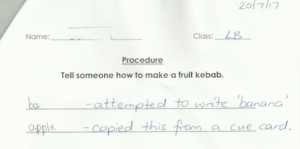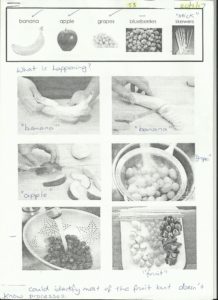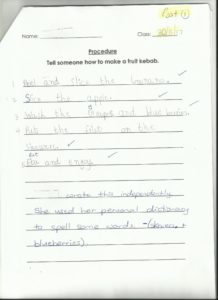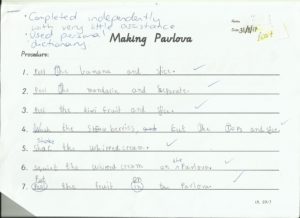Lorraine Batres is an NAP teacher (Grades 2/3/4) at the Western English Language School in Victoria, Australia, who recently completed the How Language Works course. She explains how the course helped her achieve a dramatic increase in students’ achievements, in particular using one of the course’s strategies, the Teaching and Learning Cycle.
“The teaching and learning cycle has four key stages that are well structured and easy to follow:
Stage 1: Building the Field
In this stage, students are pre-tested on the chosen topic and genre, for a clear understanding of their background knowledge. The focus is on building on that knowledge and introducing new vocabulary as EAL teachers normally would. Students learn through pictures, songs, games, audio and visual texts, books, role-plays, etc.
Stage 2: Modelling and Deconstruction
In this stage, the genre is introduced through modelled texts and the content is deconstructed. Students learn about headings, sub-headings, labelling and language features. There is a focus on functional grammar and a breakdown of words or groups of words in sentences to understand the parts and make meaning.
Stage 3: Joint Construction
In this stage, students jointly construct text with the teacher or with each other. They start to become more confident at contributing thoughts and ideas. Functional grammar continues to be a focus as students progress in their understanding of each genre and its associated language features.
Stage 4: Independent Construction
In this stage, students are given a post-assessment, which involves independent work. Students who are unable to write could still be assessed orally.
During one term, our class focussed on the genre of procedural writing with ‘Food’ as the topic. I completed a pre-assessment task with each student in my class. Some students were able to verbally identify a couple of fruit names. Only three students could identify up to five fruit names and attempted to spell the words. A couple of students were able to sequence the pictures
on the genre of procedural writing with ‘Food’ as the topic. I completed a pre-assessment task with each student in my class. Some students were able to verbally identify a couple of fruit names. Only three students could identify up to five fruit names and attempted to spell the words. A couple of students were able to sequence the pictures of the procedure in the pre-assessment and verbalize basic phrases. One student attempted to write the procedure. As a class, we spent the first couple of weeks building the field by learning new vocabulary and basic oral structures. We focussed on processes (verbs) in cooking and throughout the following weeks, we followed basicrecipes in class. I read Possum Magic to the students and we made some of the Australian foods that were presented in the book, such as Vegemite sandwiches and Pavlova. I took photos of the students cooking along the way and used these visuals as aids during writing tasks.
of the procedure in the pre-assessment and verbalize basic phrases. One student attempted to write the procedure. As a class, we spent the first couple of weeks building the field by learning new vocabulary and basic oral structures. We focussed on processes (verbs) in cooking and throughout the following weeks, we followed basicrecipes in class. I read Possum Magic to the students and we made some of the Australian foods that were presented in the book, such as Vegemite sandwiches and Pavlova. I took photos of the students cooking along the way and used these visuals as aids during writing tasks.
As a class, we read through model procedural texts and discussed structures, including the heading, subheadings and other features of the text. We deconstructed sentences together using a colour-coded scheme. We coloured all the processes green and discussed if these processes were action, saying, sensing or relating words. They started to associate my questioning to locate other information and to use the colours in the scheme. For example:
- What is happening? What did we do? (process)
- Who or what is it? (participant)
- Where, when, how, with what, with whom? (circumstance)
For example: Peel the banana and slice it into little pieces.
- What did we do? Peel and slice
- What did we peel? the banana
- What did we slice? it
- What is it? the banana
- How did we slice it? into little pieces
With this new knowledge, we moved onto joint construction of procedural texts based on the recipes that we had done or intended to do in class. We continued using the colour-coded scheme to construct sentences through questioning.
From there, I divided the students into ability groups and each group worked on independent writing at their own level. During conferences, I was able to use the metalanguage to communicate ideas to improve students’ work. For example, if a student wrote ‘Put the banana’ without specifying where, I could suggest to that student that they needed to include a circumstance of place to complete their sentence, for instance, ‘on the Pavlova’. With colour-coded model structures around the room for support, students began to see patterns in texts and subsequently used these patterns to guide their own independent writing for their post-assessment tasks.
For example, if a student wrote ‘Put the banana’ without specifying where, I could suggest to that student that they needed to include a circumstance of place to complete their sentence, for instance, ‘on the Pavlova’. With colour-coded model structures around the room for support, students began to see patterns in texts and subsequently used these patterns to guide their own independent writing for their post-assessment tasks.
By this stage, most students were able to write basic procedural texts independently. Some students were able to write detailed procedural texts using a combination of processes, participants and circumstances in the correct sentence structure.”
Thank you, Lorraine, for sharing this excellent result with us.

